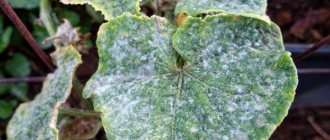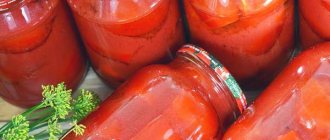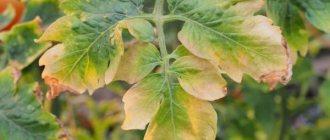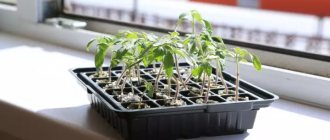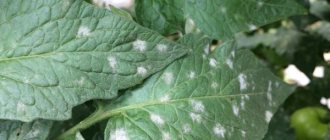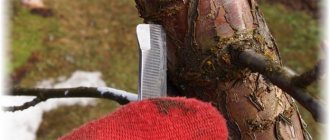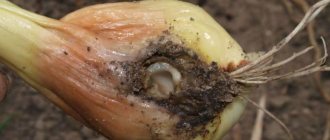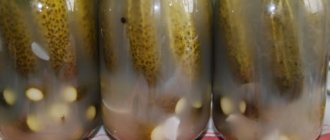The Firewood tomato is an interesting find for lovers of exotic varieties. Breeders have created a tomato that resembles a log in shape. Deserves numerous positive reviews throughout the country.
| Height | Landing location | Ripening time | Fruit color | Fruit size | Origin | Fruit shape |
| short | Greenhouse, Open ground | Mid-season | Reds | Average | Variety | Plum-shaped or oval |
Description and characteristics of the variety
The Drova tomato is a determinate, low-growing variety. The bushes are compact and strong, do not exceed 30-40 cm in height. The foliage and bushiness are moderate.
Ripening occurs in an average period - 90-100 days from germination.
Description of fruits:
- average weight varies in the range of 80-90 g;
- length 10-12 cm;
- there are few seed chambers and seeds;
- the shape is elongated, oblong, at the top there is a characteristic bifurcation;
- the skin is durable, does not crack and does not form microcracks;
- the pulp is moderately juicy, loose;
- the taste is sweetish with notes of sourness.
The fruits are used for fresh salads, pickling, and whole canning. Ketchups and sauces are delicious.
They are grown in the southern regions in open areas, in temperate zones and closer to the north in greenhouses.
Protection from diseases and pests
Let's look at what diseases threaten the plant and how to prevent their occurrence.
Diseases
Despite the developed immunity, most gardeners note that the plant is prone to macrosporiosis. The development of a pathogenic disease occurs due to nitrogen deficiency in the soil. Fixed spores of macrosporiosis are spread by wind or harmful insects. High humidity promotes the spread of spores.
At the early stage of infection, the fungus develops in the intercellular space of plants, so it is not always possible to detect it. After a few days, you will notice how the color of the foliage has changed: it has become brown and dry due to cell necrosis.
For prevention, use Bordeaux mixture. Also, do not allow excessive humidity in your greenhouse; it must be ventilated. Copper oxychloride will help cope with the disease itself.
Important . Always recondition your tool. He may be infected. Also, do not plant potatoes and other nightshades nearby, which can serve as a source of infection.
Anthracnose infection of fruits is asymptomatic until the vegetables ripen. Round spots form on the surface of a ripe tomato, which at first do not differ in color from the skin. Over time, the damaged areas grow and darken, becoming almost black in color. In the central part of the spot, an area of yellow-brown color with a large number of dark inclusions is formed.
The fruit tissues in these areas soften and rot, and the pulp acquires a bitter taste. Affected vegetables should not be eaten. The first therapeutic effect that diseased tomatoes should undergo is the immediate removal of the affected fruits from the plants.
Bushes that are heavily infected with anthracnose should be dug up and the soil underneath them should be disinfected. After this, you need to treat both diseased and healthy tomato bushes with antifungal agents at least 2-3 times. The drug "Tiovit Jet" is used.
If the plant is not properly ventilated, there is a chance that it will develop late blight. This is a fungal disease that causes a huge number of problems for gardeners. It all starts with brown spots: they quickly spread from the leaves to the stems. Late blight often leads to the death of the entire crop.
- these are chemical or biological preparations for combating fungal diseases - help prevent or delay the development of late blight
Biological - “Fitosporin” (5 g per 10 l of water), Ecosil (15 drops per 3 l of water).
Chemical - “Bordeaux liquid”, “Ridomil Gold MC”, “Tatu”, “Quadris”, others.
Protecting tomatoes from diseases. DIY fungicide
Pests
- Whitefly . The small white moth is dangerous for greenhouse tomatoes. Its secretions promote the development of sooty fungi on leaves and fruits. Whiteflies are also carriers of viral diseases and can cause chlorosis, leaf curl and other ailments in tomatoes. Whitefly larvae feed on the sap of plant leaves, leading to their death. How to fight: use the insecticide “Confidor” or other drugs with enteric contact action.
- Aphid. Potato and orange (peach) aphids live on tomatoes. It sucks juices from the leaves, reducing the plant’s immunity and negatively affecting yield. If spots, curling of leaves, or other signs of aphids are detected on tomatoes, the plants must be treated immediately, since the insect, among other things, carries the seedless virus and other diseases. How to fight: use “Bison”, “Fufanon”, “Karbofos”. Remove affected seedlings.
- Wireworm . A larva whose life cycle lasts two years. Another year after pupation, the click beetle appears. It is in the larval phase that the pest is dangerous to plants. It gnaws the roots of plantings and penetrates the stems, causing rot of tomatoes of various origins. How to fight: 3-4 days before planting the seedlings, the larvae are lured with vegetables placed on sticks and killed. “Bazudin” also exterminates wireworms well. Liming of acidic soils is also effective.
Features of cultivation and storage
The bushes are placed in a permanent place when they are 50-55 days old.
How to grow in the garden and on the balcony?
In the beds on the site, seedlings are transplanted into lighted, windless places. The best predecessors are carrots, phacelia, beets, and peas.
How to grow:
- watering 3 times a week;
- mulching;
- fertilization;
The bushes do not take steps.
To grow at home, the bushes are transferred to pots with a capacity of 4-5 liters. Drainage and soil fertile substrate are laid. Features of care on the balcony:
- additional lighting in winter;
- moderate watering;
- feeding
Pinching and tying
Cultivation is carried out to distribute the load on the plant and increase the amount of harvest. Since our tomatoes are small in size, we leave two or three sprouts that will bear fruit.
Despite their small size, Drova tomatoes can boast a large number of fruits. But there is a nuance - the bushes will not be able to support heavy tomatoes without support.
Bridle comes to the rescue: it is recommended to do it during planting of seedlings. Then the plant will stretch upward along the support of wooden stakes or rods, and not hang above the ground (the plant stem may even break). Shaping is also recommended. If the tomatoes are not formed, then the bushes will spend their energy on the growing season, and they will not have the strength to ripen the fruits.
Common mistakes when growing
Due to inexperience, many gardeners, especially beginners, make many mistakes when cultivating. As a result, they get weak seedlings or an overgrown green mass with small and unpalatable fruits. This is possible in the following cases:
- Using contaminated or old seed. The seedlings turn out to be thin, sluggish, sprout unevenly and die quickly.
- Tomatoes do not grow well in cramped containers and do not tolerate acidic, heavy soil.
- To prevent the sprouts from stretching out, they need to be planted in time - at the stage of the appearance of two cotyledons.
- Failure to comply with planting deadlines or transplantation into cold and waterlogged soil can lead to the death of sprouts or damage to them by various types of rot.
- Eating disorder. Gardeners often get confused about when and what fertilizers are needed. When nitrogenous substances are added, the bush will intensively increase its green mass. Phosphorus-potassium substances ensure good flowering and fruiting. Apply each drug at the right time and be sure to stick to the dosages. Overfeeding can cause tomatoes to stop growing, bloom and bear fruit sparingly.
- Watering, loosening and weeding are necessary to keep the soil moist, light and loose. Without these procedures, the bushes will quickly turn yellow and dry out.
Is firewood productive? It happens if it's a tomato!
All kinds of tomatoes are needed, all kinds of tomatoes are important!
In my greenhouse, each tomato has its own purpose. Today I want to talk about a super-yielding and standard tomato variety with the funny name Drova, which I grew for the first time last year! Please love and favor - Firewood! The originator of the variety, the Aelita company, promised that the variety is high-yielding and standard, suitable for both greenhouses and open ground. Height is 40-60 cm, and in the greenhouse 70-80. The bush does not require pinching. That’s how it all turned out, Aelita did not disappoint my expectations!
I sowed Drova along with other tomatoes on March 5th. The seeds sprouted well, and in seedlings the variety did not differ from others at first.
Seedlings-2020 The inscription “Firewood” is on the other side of the box, but I divide all the rows in half, which is marked with matches.
The seedlings were transplanted into 0.5 liter glasses. I gave away what was left in the box. It’s a pity that I start writing everything spontaneously, because the glass with seedlings of the Firewood variety was not removed separately. But it must be said that at the time of transplantation, Drov already began to differ from the Indets in his stockiness. The transplant into the greenhouse was done on May 11. The Drova tomato grew slowly, clearly justifying its short stature.
The originator of the variety writes that the Drova tomato is mid-early, and the first fruits can be harvested in 107-115 days. It didn't work out that way for me. It is possible that the timing was seriously adjusted by the very cold beginning of summer. The last frost was on the night of June 30 to July 1, when many people’s uncovered potatoes froze (I covered mine). It was also very uncomfortable in the greenhouses! This year I will definitely mark the start of ripening, I hope it will be in July-early August.
Firewood close-up. August 3rd
Not only in mid-July, but also in early August there was not a single ripe piece of wood yet!
But a lot of “firewood” has grown! The bush, about 70 cm high, was strewn with even, interestingly shaped fruits! I didn’t plant it, I just managed to tie the stems to the trellis. A garter is required due to the high load of fruit on the stems. I really liked the compact, not spreading shape of the bush, it was all so stocky! The fruits began to turn red in mid-August, again slowly. Fruiting was extended.
August 20. Some of the fruits have been removed. What good can be said about these “firewood”? The weight of the fruit is 80-100 grams (I weighed it, but did not remove it, but I should get into such a good habit of filming the weighing of any tomatoes and cut-away fruits). Tomatoes do not crack, they do not have a green spot at the base (I love this!) The fruits are fleshy, dense, the walls are thick, there are chambers, and there are few seeds and juice. They write that they are suitable for juice... No, they are not suitable, I think. But they are very good for tomato paste, pickling with whole fruits and drying.
The purpose of my growing the Drova tomato was drying (my daughter dries a lot of tomatoes) and canning. They are also good for “eating”, because the tomatoes are sweet, with a wonderful tomato aroma, but in our family they prefer to eat either large-fruited tomatoes or tasty little things. And I didn’t just let the “firewood” eat, I saved it for drying! Cutting firewood into rings into a salad is very good!
The Firewood bore fruit until the end of September. Now pay attention to the tomato lying on the ground. Lying here he ripened. The only drawback of the Drova tomato is that if you handle the bush carelessly, you can knock off the fruits. Realizing this, I tried not to climb near the bush like a bear!
So, why did I highly appreciate the Drova tomato? Standard bush. I highly recommend it to those seven-dacha owners who grow tomatoes in open ground. And I just grow all my tomatoes in a greenhouse, because late blight will attack them outside. There is no need to step-son - minus one hassle! The fruits are tasty and store well! The fruits are used universally, except for juice.
I know that many people are already growing Firewood (it’s a funny phrase, isn’t it?), and if anyone has not yet tried this tomato variety, I wholeheartedly recommend it! I appreciated it, loved it, and thanks to Aelita for it! Now he will be a permanent resident of my greenhouse.
From the competition partner, the online store Seedspost.ru offers you to familiarize yourself with the seed catalog, where you can choose and purchase the vegetable seeds you like, including the 'Firewood' tomato.
Transplanting to a garden bed
Typically this procedure is carried out in late spring - early or mid-May. By this time, the plants will get stronger, reach a length of 25-30 cm and produce 5-6 leaves.
Site preparation
In an open garden for tomatoes, choose a sunny place with the possibility of shading during lunch hours. The soil should be light, loose and neutral acidity. Before planting tomatoes, the area is cleared of weeds and last year’s vegetation, and sprayed with a solution of copper sulfate for disinfection (1 tbsp per bucket of water).
A day after treatment, sprinkle with humus - 10 kg, ash - 3 kg and superphosphate with potassium salt - 100 g/m². The soil is dug up, leveled with a rake and watered.
Planting scheme
Tomatoes need to be fed
Drowa tomatoes have a compact bush shape, so they do not require much space on the site - the optimal planting pattern is 40x50 cm.
Each hole is spilled with water, then the plants are planted, pressing down the soil around the trunk and covering it with garden soil.
Care requirements
In the first days of adaptation, tomatoes need to be covered with any material from the sun, and at night - from the cold.
Aftercare consists of several activities.
- Plants begin to be watered a week after planting. To avoid burns and rotting of bushes, watering is carried out on cloudy days in the evening or in the morning. Water is poured under the root, and after the moisture is absorbed, the soil is mulched.
- Every other day, loosening, weeding and, if necessary, removal of weeds are carried out.
- During the entire growing season, tomatoes need to be fed at least three times. The first fertilizer is applied three weeks after transplanting the bushes to the garden bed. Use nitrophoska or azofoska - 1 tbsp. l. on a bucket of water. At the beginning of flowering, the bushes are watered with a liquid complex composition of superphosphate (15 g), potassium nitrate (10 g) and 10 liters of water. Each bush uses 0.5 liters of fertilizer. This fertilizing is also applied at the stage of fruit filling. To protect against diseases and improve the quality of flowering and fruiting, you can feed the bushes with boron - 0.2 g of the substance per liter of warm water (60°C). Irrigate the garden bed before and after flowering.
- This plant does not require pinching or staking, as it is small in size and compact in shape. But if you want to get a larger harvest of tomatoes, you should pinch the central conductor after 2 flower clusters appear. You can also pluck all the foliage at the bottom of the bush so that the tomatoes can devote all their energy and nutrients to the formation and ripening of vegetables.
- To attract bees to the garden, tomatoes are sprayed with honey solution - 1 tsp. per liter of water. This will increase the amount of harvest.
- Vegetables are harvested three months after transplanting the seedlings to the garden bed. You can pick both ripe and unripe (brown) fruits. They ripen well indoors and are stored in a cool place for several months.
Basic care
To obtain strong sprouts, it is necessary to create certain conditions:
- cover the crops with transparent film or glass;
- place in a warm place with diffused light;
- the optimal temperature for germination is 20-23°C, humidity - 60%;
- You need to periodically ventilate and irrigate the dried soil.
5-7 days after the sprouts appear, the cover is removed and the seedlings are placed in a shaded place. For a week, the seedlings are kept at a temperature of 18-19°C to prevent them from stretching and stimulate root growth. Then the sprouts are returned to their original location.
When two cotyledon leaves are formed, the sprouts are planted. Before planting in a larger container, the crops are watered abundantly and then removed along with the earthen clod. The voids are filled with fertile soil - garden soil mixed with humus (1:1).
For better survival, the sprouts need to be fed with an azofoska solution (1 tbsp per 5 liters of water) or a urea solution (1 tbsp per bucket of water). Consumption per plant - 200 ml.
Reviews
Despite its relative youth, the “Firewood” tomato has earned a lot of positive feedback from gardeners.
I planted these tomatoes for the first time last year. To be honest, I didn’t expect such small bushes to have such a large number of fruits. I didn't think about the garter and they just broke. They ripened in the gazebo, but I didn’t really like the taste. Used for salads. They keep their shape perfectly. I studied the characteristics of the variety and realized that I had made a bunch of mistakes. This time I will plant the bushes less frequently and will definitely tie them to the supports. I hope everything works out.
I just recently moved into my own house with my husband, and now my hobby is experimenting in my garden. I constantly buy new varieties. I planted “Drova” tomatoes on the plot. Yes, the harvest is excellent, I also liked the taste, but that’s not the main thing. I planted them in flower pots in December and by the end of March we were eating fresh tomatoes. Moreover, this is without additional lighting and without fertilizing. I sometimes used only sweet water, like for indoor plants. Very pleased.
Try growing a “Firewood” tomato. It's not difficult at all, and the result will definitely please you.
Growing seedlings
The technology for growing seedlings at home consists of several stages.
- To plant the Drova variety, it is better to use purchased tomato seeds with the current expiration date. Material collected from last year's harvest should be pre-processed. First you need to discard unsuitable seeds - dip them in a saline solution (½ tsp per 0.5 liters of water). After half an hour of soaking, all the seeds that have sunk to the bottom are removed, washed and dipped in a raspberry solution of potassium permanganate for half an hour. This will help destroy all pathogenic microflora. After treatment, the seeds are dipped in Epin solution for half an hour, which will increase the percentage of their germination and good growth. Before sowing, the seeds are placed in damp gauze and kept for a day in a warm and dark place. This way they will hatch faster and sprout.
- Preparing containers. It is better to use disposable containers or peat tablets - then there will be no need for picking. When planting in boxes or plastic containers, the grown seedlings will need to be planted in separate containers. Requirements for planting containers: height of at least 10 cm, presence of drainage holes.
- For seeds, it is necessary to use light, loose and fertile soil, preferably with a neutral acidity level. A balanced composition for growing vegetable crops is sold in any gardening store. You can prepare it yourself - mix equal parts of garden soil, humus and sand. Before use, the soil must be sterilized: treated with a raspberry solution of potassium permanganate, calcined in the oven or poured with boiling water.
- Sowing technique. The optimal timing is the end of March or the beginning of April. In 55-60 days, the seedlings will be ready to be transplanted into an open bed or greenhouse. In boxes, seeds are sown in grooves up to 1 cm deep and at a distance of 3-4 cm from each other. In disposable containers, place 2 seeds on the surface of the soil and sprinkle with a thin layer of sand.
Advantages and disadvantages
| pros | Minuses |
|
|
